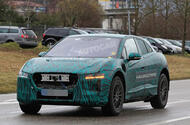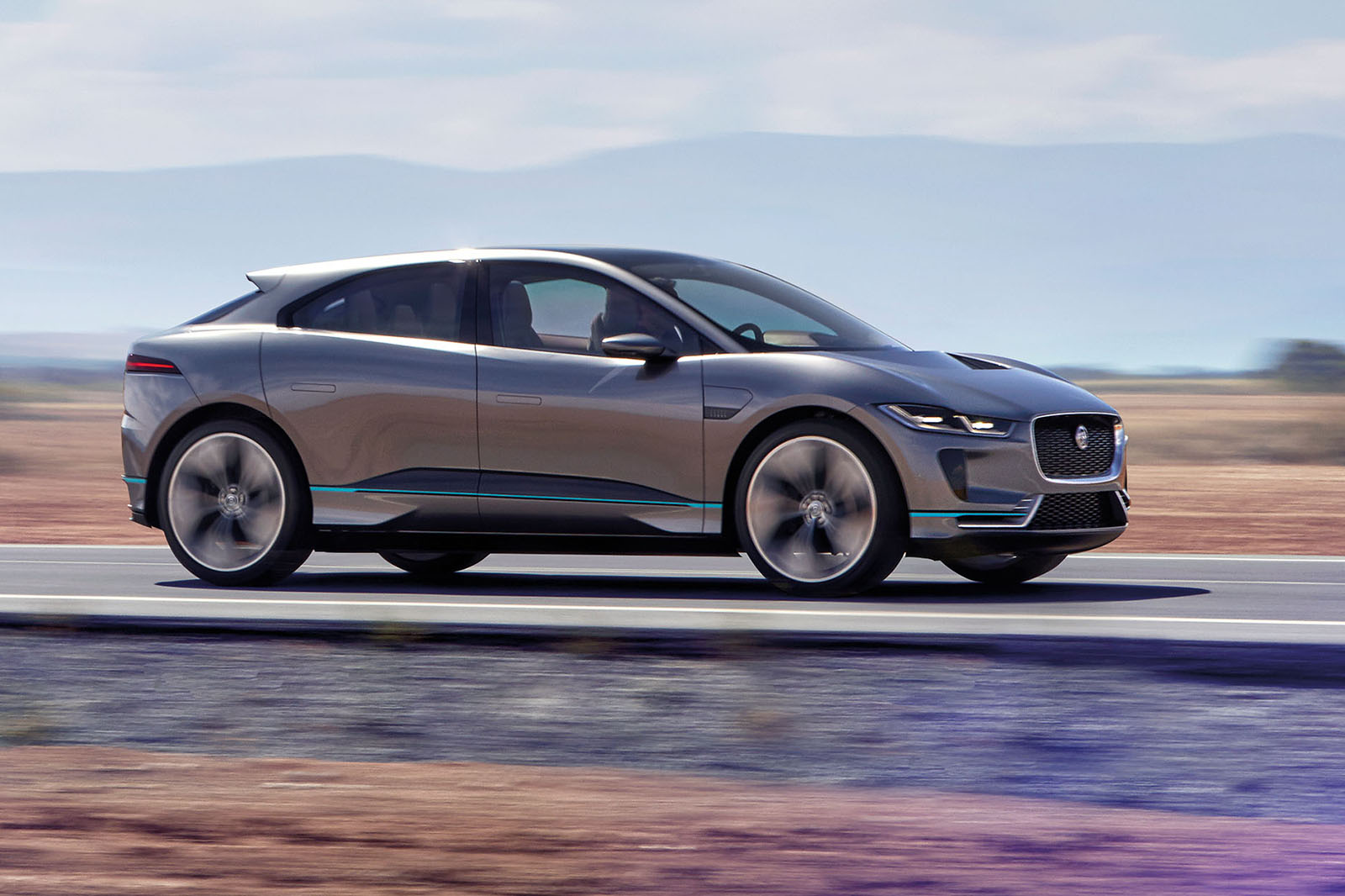Jaguar I-Pace: development flat out ahead of 2018 launch
 Jaguar is racing to get its first electric car to market before the Audi E-Tron; it's due to arrive at the Geneva motor show
Jaguar is racing to get its first electric car to market before the Audi E-Tron; it's due to arrive at the Geneva motor show
Jaguar engineers are flat out in the development of the I-Pace, using multiple test cars in several locations across Europe as the race to market ramps up.
The I-Pace is targeted with beating the Audi E-Tron into showrooms next year in order to earn the title of first electric SUV from a premium car maker. Although the Tesla Model X, which is already on sale, is technically the first EV SUV, insiders claim the Jaguar and Audi will offer a more traditional SUV experience, so fall into a slightly different segment.
Jaguar is tipped to reveal its production-ready I-Pace at the the Geneva motor show in March. This is also a likely venue for the production E-Tron's public debut, emphasising how close the sprint to market is.
First drive of Jaguar I-Pace electric SUV concept
These latest spy pictures of the I-Pace were captured in Germany, but the brand is also running development cars in Britain and other European locations, meaning the I-Pace's total test mileage is rising at an extremely fast rate.
Although the spotted test cars are heavily disguised, the fact that engineers are happy for them to be left in public spaces with branding on the camouflage - swirled green livery that mimics the team's Formula E racing colours - confirms that the car is nearing its final stages of development.
Jaguar I-Pace eTrophy racing series to support Formula E
Jaguar I-Pace - what we know so far
The price of the production car is expected to be about 10-15% above that of an F-Pace of similar specification. Jaguar remains tight-lipped on precise details, but the I-Pace is expected to cost around £60,000.
The I-Pace is billed by insiders as the most radical car in Jaguar's 81-year history and will vault the brand directly into Tesla territory, with the Model X a key rival.

Read about the I-Pace's EV tech here
Jaguar’s brief for its long-anticipated first electric vehicle was to “create a performance SUV that is spacious, sporty and usable”, but the final design isn’t just an electric version of the successful F-Pace SUV.
Instead, the I-Pace exploits the packaging advantages of an electric powertrain to marry a sleek four-door bodystyle with generous cabin space, four-wheel drive capability and performance on a par with a rear-wheel-drive Jaguar F-Type R.

NEW EV ARCHITECTURE
The I-Pace uses a new, bespoke battery-electric vehicle architecture designed in-house. Jaguar says the electric architecture, informally referred to as the ‘electric skateboard’, is production ready.
As with other Jaguars, the I-Pace’s architecture is aluminium-intensive. The housing of the battery pack is made from the material and forms an integral part of the car’s body structure.
Read more about the design of the I-Pace here
The I-Pace’s drive is provided by a pair of synchronous permanent magnet electric motors, one integrated into each axle and paired with a single-speed epicyclic transmission. The powertrain provides four-wheel drive, immediate response from a standstill and rapid torque distribution between the two axles.
Each motor produces the equivalent of 197bhp, meaning the I-Pace concept has 395bhp and 516lb ft on tap. Jaguar’s claimed 0-60mph time for the car is 4.0sec.
“Electric motors provide immediate response with no lag, no gearshifts and no interruptions,” said JLR vehicle line director Ian Hoban. “Their superior torque delivery compared to internal combustion engines transforms the driving experience.”
The car’s maximum range on a fully charged battery is about 310 miles, as measured on the New European Driving Cycle.
A 50kW direct current (DC) charging point - currently the most common type of public rapid charging system in the UK - can replenish the battery to 80% in 90 minutes and to 100% in just over two hours.
Jaguar has future-proofed the electrical architecture to accept higher-capacity charging than 50kW DC when such charging points become commonplace. The charging socket is situated in the car’s front wing.

Jaguar’s engineers designed and developed the motors in-house to achieve the compactness, efficiency and power density they desired. The motors have an outer diameter of 234mm, are 500mm long and weigh about 38kg. Permanent magnet motors were chosen in preference to the induction motors used by the likes of Tesla because the efficiency is fractionally better and the weight is lower.
Power is stored in a 90kWh lithium ion battery pack. The battery uses 36 pouch cells selected for their energy density and thermal performance. They operate at a lower heat, so they can run at a high performance for longer than cylindrical cells.
Jaguar said pouch cells offer excellent future development potential, especially in terms of energy density. This will enable greater range for a given size of battery, or deliver similar range to today but from a smaller, lighter pack.
The pack is liquid-cooled using a dedicated two-mode cooling circuit. In moderate ambient temperatures, the battery improves efficiency by relying only on a radiator to remove the heat generated by the cells. At higher temperatures, a chiller linked to the vehicle’s main air conditioning system provides greater cooling capacity to keep the battery in optimum condition.
DRIVING DYNAMICS
Jaguar set out to ensure the concept version of the I-Pace can top its class in terms of ride, handling and refinement. The car uses the same double wishbone front suspension and integral link rear suspension that has already been proven in the F-Pace.
Siting the battery pack low between the axles helps to lower the centre of gravity and reduce yaw inertia, and spreading the weight of the electric motors on to each axle has helped to enable a front-to-rear weight distribution of almost 50/50. The concept rides on 23in alloy wheels and bespoke 265/35 R23 tyres and uses electromechanical steering.

“It’s a true Jaguar,” said Mike Cross, JLR's chief engineer of vehicle integrity. “This will be the first electric vehicle developed for enthusiasts who love driving.”
The I-Pace’s four-wheel drive system is augmented by Jaguar’s familiar traction technologies, including All Surface Progress Control (ASPC) and Adaptive Surface Response (AdSR). The car will also have adjustable levels of regenerative braking force, making it possible to drive the I-Pace as a ‘one-pedal’ car in some conditions.
CAB-FORWARD DESIGN
Not having to accommodate an internal combustion engine or conventional transmission allowed Jaguar’s designers and engineers to rethink the vehicle’s overall proportions.
Although an SUV design wasn’t a prerequisite at the very start of the electric vehicle project, it was a logical choice: the F-Pace is now the company’s best-selling model and Jaguar’s electric car needs to appeal particularly to the US market, where emissions regulations are tightening. Jaguar has even launched a button on its site to register interest in the I-Pace.
Even so, the I-Pace is an unconventional SUV, taking some of its styling cues from the stillborn hybrid C-X75 supercar. A cab-forward design, long wheelbase and short overhangs combine to maximise interior space for occupants, improve visibility and enhance driving dynamics.
At 4680mm long, 1890mm wide and 1560mm tall, the I-Pace Concept is smaller in each dimension than the F-Pace, in particular its height. However, the most significant difference is in the wheelbase: Jaguar has pushed the electric car’s out to 2990mm, compared with the F-Pace’s 2874mm. Indeed, the I-Pace’s wheelbase is 30mm longer than the XF’s, too.
To reduce drag, the door handles sit flush with the body surface and slide out when activated, and side skirts channel air more efficiently around the wheels. A lowset bonnet features a grille that bends back to channel air through a scoop similar to that of the C-X75, helping to reduce drag further. The drag coefficient is 0.29. By comparison, Tesla claims its Model X is the slipperiest SUV, with a Cd of 0.24.
At the rear of the roof, a slender fixed spoiler reduces lift at higher speeds without generating drag. The dramatically sloping rear window has a hydrophobic glass coating that sheds water, negating the need for a rear windscreen wiper. The squared-off rear end and flared haunches accentuate the short rear overhang but also provide an aerodynamic benefit by encouraging air to cling to the vehicle for longer, stabilising airflow at speed.
In place of exhaust pipes, there are rear vents that help to channel turbulent air from the rear wheel arches into the vehicle’s wake, as well as a rear diffuser. The tail-lights feature a ‘chicane line’ signature, a new Jaguar design element that replaces the more traditional E-Type-inspired roundel.
FUTURISTIC INTERIOR
The I-Pace Concept’s interior is a “clear statement of plans for the production version” of Jaguar’s electric vehicle, and some elements also reflect a design philosophy that will be transferred to other future models.

The cabin takes advantage of the packaging of the electric architecture to maximise occupant space and offer a new minimalist cockpit design. The flat floor allows the driver and passengers to sit lower than in a conventional SUV. Slimline seats position the occupants’ hips lower in relation to their heels in what Jaguar calls its ‘Sports Command’ driving position. The aim of this is to offer a sports car’s sense of connection with the road even in higher-riding vehicles.
A floating centre console emphasises the car’s flat floor and the absence of a gear selector and transmission tunnel, and it has a stowage area for oddments underneath. The gears are selected via buttons integrated into the centre console’s metal struts.
The absence of a transmission tunnel has also enabled Jaguar’s interior designers to incorporate an eight-litre stowage area between the front seats. There’s a 530-litre boot and an extra 28 litres of stowage under the bonnet.
Jaguar says the I-Pace offers more rear passenger space than some full-sized SUVs and luxury saloons, despite having a smaller footprint than a conventional mid-sized SUV. There’s up to 71mm of knee room for rear passengers.
The full-length panoramic glass roof features a lozenge-patterned ceramic print that becomes illuminated at night via an array of LED lights embedded in it.
MORE TOUCHSCREENS
The I-Pace Concept introduces a new cockpit design philosophy based around three display screens. The primary interface is a 12.0in TFT touchscreen, and the infotainment and climate functions are adjusted on a secondary 5.5in screen operated by two aluminium rotary controllers. Instrumentation is presented on a configurable 12.0in virtual cluster augmented by a colour head-up display.
The cockpit also has a new three-spoke steering wheel, which features multi-function capacitive switches that react with haptic feedback when pressed.
The infotainment system has been designed in-house and is built upon the same technology that powers the InControl Touch Pro system offered in Jaguar’s current models. Other technology present on Jaguar’s existing crop of production cars, such as a wi-fi hotspot and the ability to use apps from a connected smartphone or tablet via InControl Apps, also features.
Jaguar’s interior designers have incorporated about a dozen special features into the cabin of the I-Pace. These include laser-etched detailing on the instrument panel surface that shows the GPS co-ordinates of the design studio in which the I-Pace Concept took shape, jaguar paw prints stitched into the seams of the seats and the outline of driving gloves etched into the pop-out tray on the passenger’s side of the dashboard.
The exterior colours of the I-Pace Concept mirror those of the I-Type, Jaguar’s single-seat electric racing car currently competing in Formula E. The manufacturer says lessons it has learned about battery performance at high speeds on the track are being fed back into the road car division.
Read more:
Comments
Post a Comment